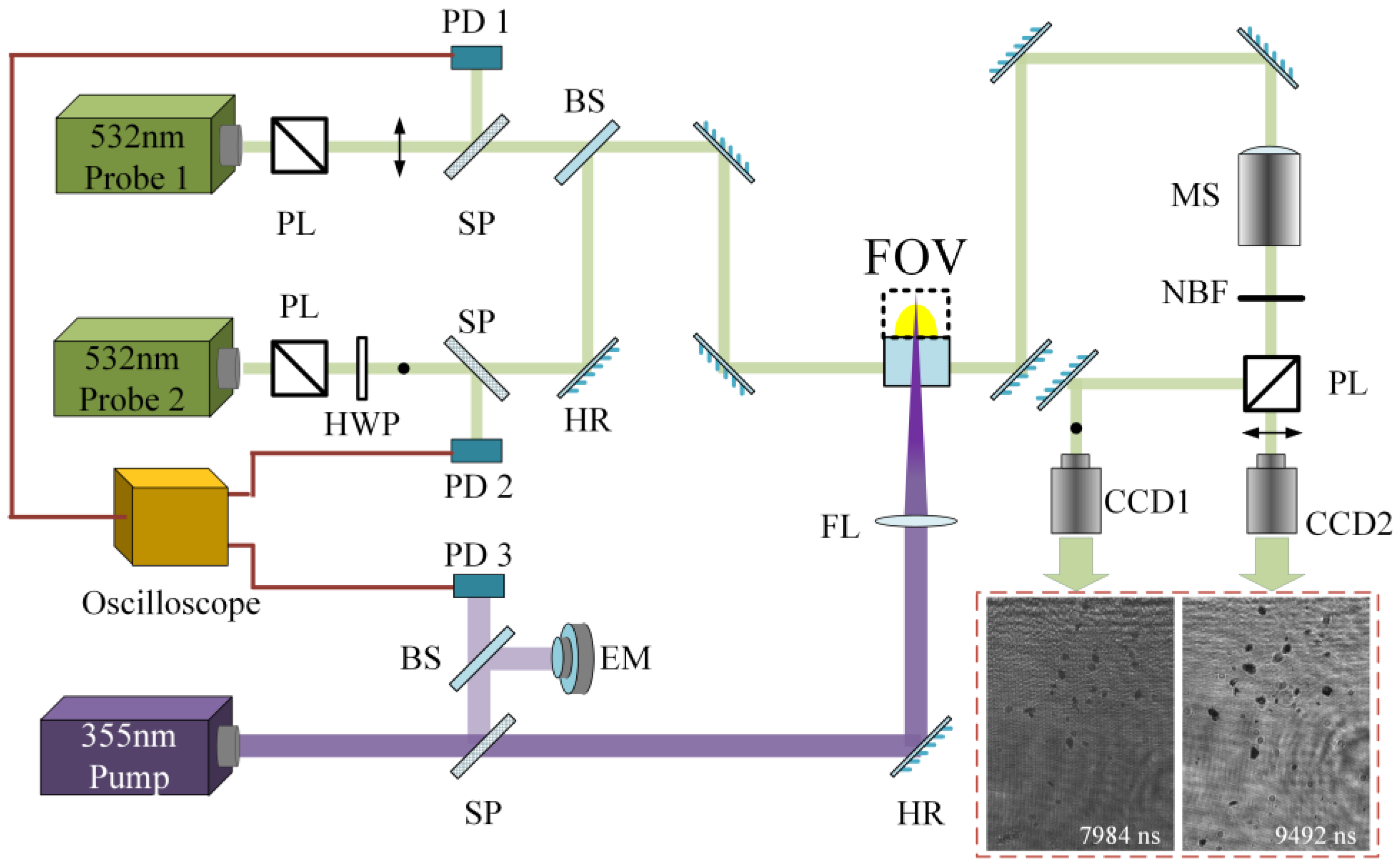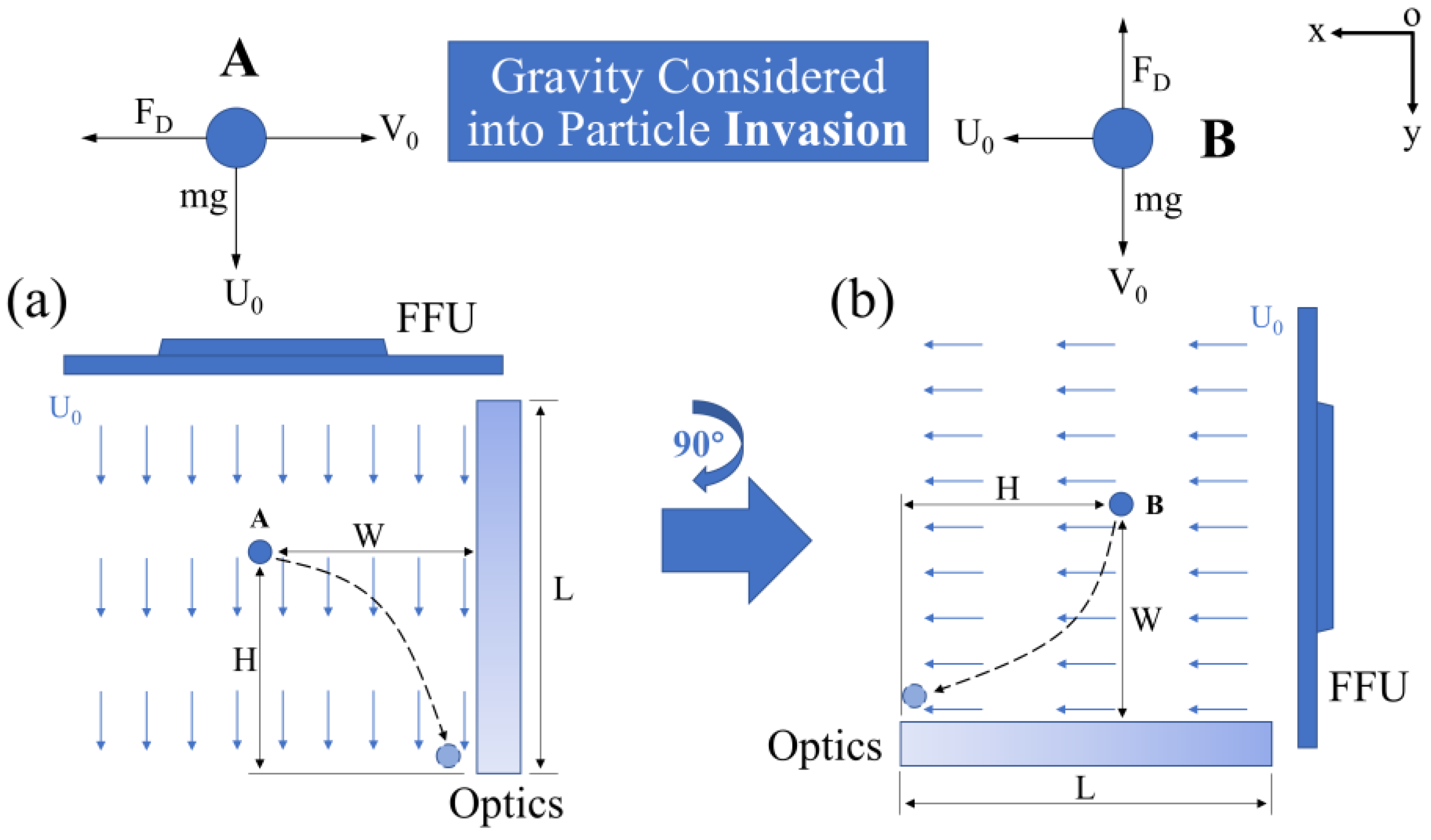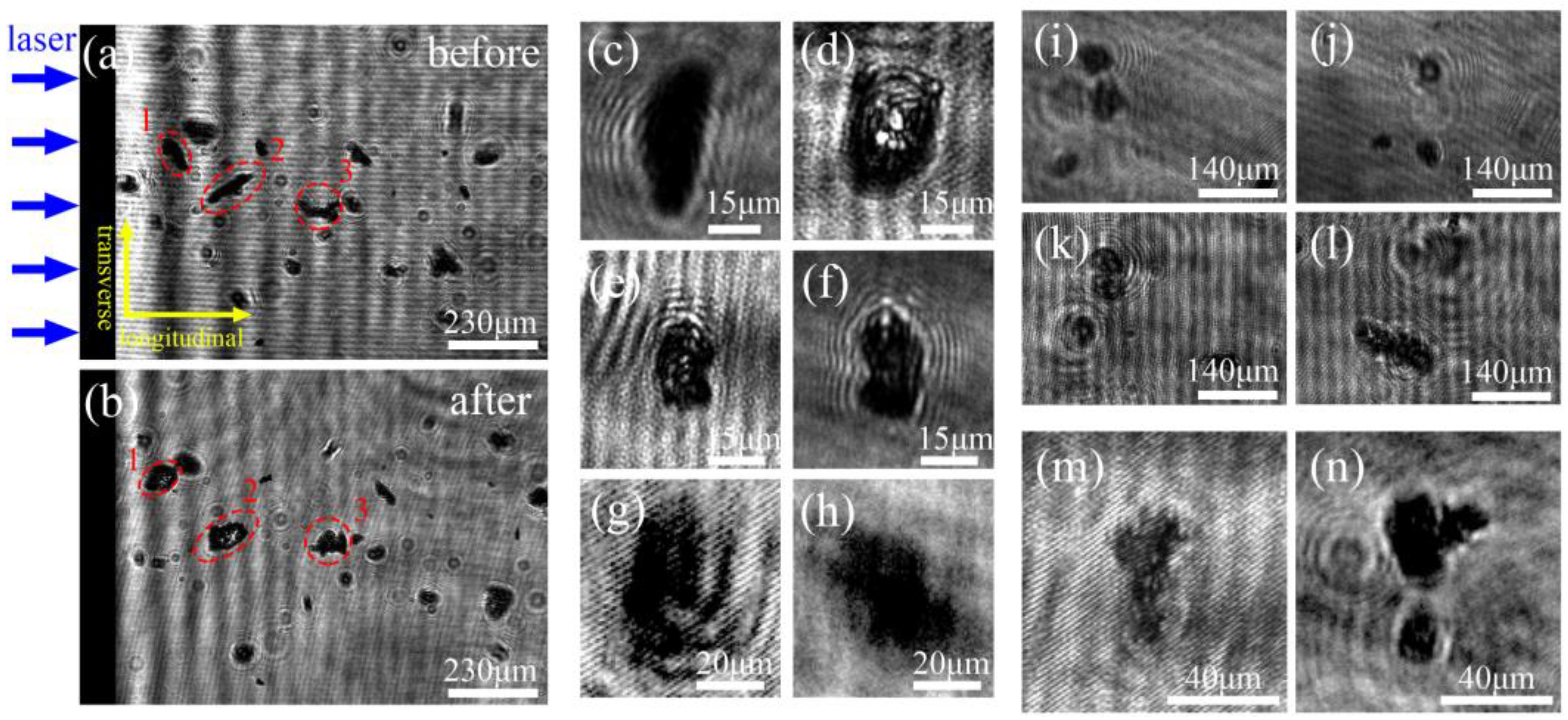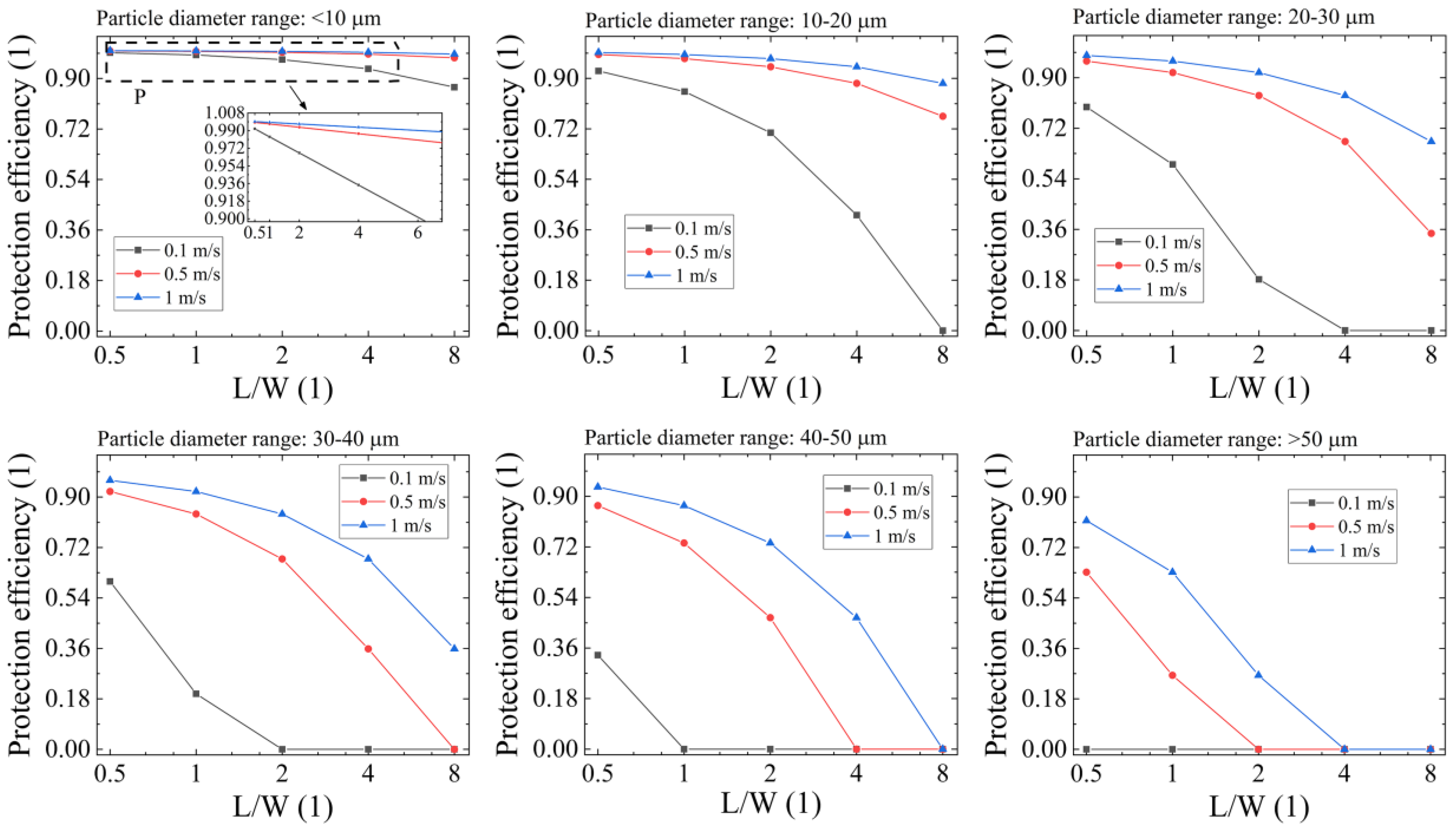Surface Cleanliness Maintenance with Laminar Flow Based on the Characteristics of Laser-Induced Sputtering Particles in High-Power Laser Systems
Abstract
:1. Introduction
2. Experimental Design
3. Particle Flight Equations
4. Results and Discussion
5. Conclusions
- (1)
- The movement of particles after initial deceleration (13,000 ns) is governed by two regimes (classified by Reynolds numbers), the Allen regime and the Stokes regime, with the Allen regime being the dominant factor.
- (2)
- The time it takes for particles to reach their terminal velocity vertically is approximately the same as the time it takes to transition from their initial velocity (corresponding Reynolds number) to Re = 1, but much shorter than the time it takes to transition from Re = 1 to Re = 0.
- (3)
- To prevent particles from directly invading, a hypervelocity laminar flow is necessary when the interval between optical components is less than the safety distance (particle’s maximum attenuation distance). However, as the interval approaches the safety distance, the laminar flow velocity decreases to several meters per second. Therefore, increasing the interval between optical components closer to the safety distance during application is more cost-effective.
- (4)
- If it is not feasible to reduce the distance within the safety distance, alternative measures, such as using a gas knife, may be considered in the future.
- (5)
- A laminar flow velocity greater than 1 m/s allows the particle’s gravitational motion to be controlled solely by the flow. This observation provides insight into designing flow-based clean systems.
- (6)
- A laminar flow velocity of 0.5 m/s can effectively prevent particle sedimentation.
Author Contributions
Funding
Data Availability Statement
Acknowledgments
Conflicts of Interest
References
- Clark, D.S.; Weber, C.R.; Kritcher, A.L.; Milovich, J.L.; Patel, P.K.; Haan, S.W.; Hammel, B.A.; Koning, J.M.; Marinak, M.M.; Patel, M.V. Modeling and projecting implosion performance for the National Ignition Facility. Nucl. Fusion 2018, 59, 32008. [Google Scholar] [CrossRef]
- Lei, Y.; Sakakura, M.; Wang, L.; Yu, Y.; Wang, H.; Shayeganrad, G.; Kazansky, P.G. High speed ultrafast laser anisotropic nanostructuring by energy deposition control via near-field enhancement. Optica 2021, 8, 1365–1371. [Google Scholar] [CrossRef]
- Shaykin, A.; Ginzburg, V.; Yakovlev, I.; Kochetkov, A.; Kuzmin, A.; Mironov, S.; Shaikin, I.; Stukachev, S.; Lozhkarev, V.; Prokhorov, A. Use of KDP crystal as a Kerr nonlinear medium for compressing PW laser pulses down to 10 fs. High Power Laser Sci. 2021, 9, e54. [Google Scholar] [CrossRef]
- Smalyuk, V.A.; Weber, C.R.; Landen, O.L.; Ali, S.; Bachmann, B.; Celliers, P.M.; Dewald, E.L.; Fernandez, A.; Hammel, B.A.; Hall, G. Review of hydrodynamic instability experiments in inertially confined fusion implosions on National Ignition Facility. Plasma Phys. Contr. F 2019, 62, 14007. [Google Scholar] [CrossRef]
- Zylstra, A.B.; Kritcher, A.L.; Hurricane, O.A.; Callahan, D.A.; Ralph, J.E.; Casey, D.T.; Pak, A.; Landen, O.L.; Bachmann, B.; Baker, K.L. Experimental achievement and signatures of ignition at the National Ignition Facility. Phys. Rev. E 2022, 106, 25202. [Google Scholar] [CrossRef] [PubMed]
- Miquel, J.; Prene, E. LMJ & PETAL status and program overview. Nucl. Fusion 2018, 59, 32005. [Google Scholar]
- Zheng, W.; Wei, X.; Zhu, Q.; Jing, F.; Hu, D.; Yuan, X.; Dai, W.; Zhou, W.; Wang, F.; Xu, D. Laser performance upgrade for precise ICF experiment in SG-III laser facility. Matter Radiat. Extrem. 2017, 2, 243–255. [Google Scholar] [CrossRef] [Green Version]
- Lee, G.J.; Choi, C.; Kim, D.H.; Song, Y.M. Bioinspired artificial eyes: Optic components, digital cameras, and visual prostheses. Adv. Funct. Mater. 2018, 28, 1705202. [Google Scholar] [CrossRef]
- Demos, S.G.; Negres, R.A. Morphology of ejected particles and impact sites on intercepting substrates following exit-surface laser damage with nanosecond pulses in silica. Opt. Eng. 2017, 56, 11016. [Google Scholar] [CrossRef] [Green Version]
- Raman, R.N.; Negres, R.A.; Demos, S.G. Kinetics of ejected particles during breakdown in fused silica by nanosecond laser pulses. Appl. Phys. Lett. 2011, 98, 51901. [Google Scholar] [CrossRef]
- Peng, G.; Zhang, P.; Dong, Z.; Chen, J.; Liang, L.; Zhu, C.; Gao, Q.; Lu, L. Spatial sputtering of fused silica after a laser-induced exploding caused by a 355 nm nd: YAG laser. Front. Phys. 2022, 10, 980249. [Google Scholar] [CrossRef]
- Li, Y.; Bai, Q.; Guan, Y.; Zhang, P.; Shen, R.; Lu, L.; Liu, H.; Yuan, X.; Miao, X.; Han, W. In situ plasma cleaning of large-aperture optical components in ICF. Nucl. Fusion 2022, 62, 76023. [Google Scholar] [CrossRef]
- Pryatel, J.A.; Gourdin, W.H.; Frieders, S.C.; Ruble, G.S.; Monticelli, M.V. Cleaning practices and facilities for the National Ignition Facility (NIF). In Laser-Induced Damage in Optical Materials; SPIE: Paris, France, 2014; pp. 390–410. [Google Scholar]
- Aktij, S.A.; Taghipour, A.; Rahimpour, A.; Mollahosseini, A.; Tiraferri, A. A critical review on ultrasonic-assisted fouling control and cleaning of fouled membranes. Ultrasonics 2020, 108, 106228. [Google Scholar] [CrossRef] [PubMed]
- Wang, P.; Han, H.; Tian, C.; Liu, R.; Jiang, Y. Experimental study on dust reduction via spraying using surfactant solution. Atmos. Pollut. Res. 2020, 11, 32–42. [Google Scholar] [CrossRef]
- Kearney, K.; Hammond, P. Particle removal using resonant laser detachment. Surf. Contam. Clean. 2003, 1, 335. [Google Scholar]
- Liu, Y.; Maruyama, H.; Matsusaka, S. Effect of Particle Impact on Surface Cleaning Using Dry Ice Jet. Aerosol Sci. Technol. 2011, 45, 1519–1527. [Google Scholar] [CrossRef] [Green Version]
- Gushwa, K.E.; Torrie, C.I. In Coming clean: Understanding and mitigating optical contamination and laser induced damage in advanced LIGO. In Laser-Induced Damage in Optical Materials; SPIE: Paris, France, 2014; p. 923702. [Google Scholar]
- Peng, G.; Gao, Q.; Dong, Z.; Chen, J.; Zhang, P.; Lu, L. Low-speed gas knife protection for the large aperture optical component in high-power laser systems. Front. Phys. 2023, 11, 1061541. [Google Scholar] [CrossRef]
- Xiao, H.; Du, C.; Zhang, S.; Zhu, Y. Study on the Surface Morphology of Micro-Particles and the Oxide Layer on Silicon Carbide Crystal Using Nanosecond Green Laser Cleaning Assisted with Airflow. Crystals 2022, 12, 1788. [Google Scholar] [CrossRef]
- Peng, G.; Chen, J.; Lu, L.; Miao, X.; Dong, Z.; Leng, D. Dual dynamic airflow protection for the removal of fused silica micron particles in the final optics assembly. Aerosol Sci. Technol. 2020, 54, 342–352. [Google Scholar] [CrossRef]
- Chen, M.; Cheng, J.; Yuan, X.; Liao, W.; Wang, H.; Wang, J.; Xiao, Y.; Li, M. Role of tool marks inside spherical mitigation pit fabricated by micro-milling on repairing quality of damaged KH2PO4 crystal. Sci. Rep. 2015, 5, 14422. [Google Scholar] [CrossRef] [Green Version]
- Dong, Z.; Yan, Y.; Peng, G.; Li, C.; Geng, Y. Effects of sandwiched film thickness and cutting tool water contact angle on the processing outcomes in nanoskiving of nanowires. Mater. Des. 2023, 225, 111438. [Google Scholar] [CrossRef]
- Bai, Q.; Li, Y.; Zhang, K.; Wang, C.; Yuan, X.; Zhang, F. Cleaning State of the Loop Case for Optical Crystal Module in Final Optics Assembly. Nanomanuf. Metrol. 2018, 1, 260–267. [Google Scholar] [CrossRef]
- Zhu, D.; Li, P.; Chai, X.; Feng, B.; Peng, Z. General design and experiment for separated final optics assembly on high energy laser system. Opt. Laser Technol. 2020, 128, 106213. [Google Scholar] [CrossRef]
- Wang, M.; Wang, B.; Miao, X.; Cheng, X.; Wu, W. Status of cleanliness maintaining in target beam enclosures in SG III facilities and contamination sources analysis. In Proceedings of the 7th International Symposium on Advanced Optical Manufacturing and Testing Technologies: Large Mirrors and Telescopes, Harbin, China, 26–29 April; SPIE: Paris, France, 2014; pp. 54–60. [Google Scholar]
- Stowers, I.F.; Horvath, J.A.; Menapace, J.A.; Burnham, A.K.; Letts, S.A. Achieving and maintaining cleanliness in NIF amplifiers. In Proceedings of the Third International Conference on Solid State Lasers for Application to Inertial Confinement Fusion, Monterey, CA, USA, 7–12 June 1998; SPIE: Paris, France, 1999; pp. 609–620. [Google Scholar]
- Stolz, C.J. Status of NIF mirror technologies for completion of the NIF facility. In Advances in Optical Thin Films III; SPIE: Paris, France, 2008; pp. 420–430. [Google Scholar]
- Wang, B.X.; Wang, M.C.; Zhu, M.Z.; Chen, X.J.; Wu, W.K. Optical surface cleanliness inspection, degradation and maintaining in high power laser system. In Advanced Materials Research; Trans Tech Publications: Zurich, Switzerland, 2013; pp. 2288–2293. [Google Scholar]
- Spaeth, M.L.; Manes, K.R.; Honig, J. Cleanliness for the NIF 1ω laser amplifiers. Fusion Sci. Technol. 2016, 69, 250–264. [Google Scholar] [CrossRef]
- Vutla, S.R.; Regalla, S.P.; Ramaswamy, K. Life cycle assessment of cleanroom for micro-electro-mechanical systems fabrication with insights on sustainability. J. Clean. Prod. 2021, 282, 124520. [Google Scholar] [CrossRef]
- Lin, T.; Hu, S.; Xu, T. Developing an innovative fan dry coil unit (FDCU) return system to improve energy efficiency of environmental control for mission critical cleanrooms. Energy Build. 2015, 90, 94–105. [Google Scholar] [CrossRef]
- Chu, S.; Fu, B.; Hu, S.; Jhou, S. Numerical Study on an Airflow Field of a Reticle Stocker with a Moving Crane in a Mini-Environment. Atmosphere 2017, 8, 23. [Google Scholar] [CrossRef] [Green Version]
- Havet, M.; Hennequin, F. Experimental characterization of the ambience in a food-processing clean room. J. Food Eng. 1999, 39, 329–335. [Google Scholar] [CrossRef]
- Alsved, M.; Civilis, A.; Ekolind, P.; Tammelin, A.; Andersson, A.E.; Jakobsson, J.; Svensson, T.; Ramstorp, M.; Sadrizadeh, S.; Larsson, P.A. Temperature-controlled airflow ventilation in operating rooms compared with laminar airflow and turbulent mixed airflow. J. Hosp. Infect. 2018, 98, 181–190. [Google Scholar] [CrossRef] [Green Version]
- Romano, F.; Gustén, J.; De Antonellis, S.; Joppolo, C.M. Electrosurgical smoke: Ultrafine particle measurements and work environment quality in different operating theatres. Int. J. Environ. Res. Public Health 2017, 14, 137. [Google Scholar] [CrossRef]
- Hu, S.; Ku, C.; Shih, Y.; Hsu, K. Dynamic analysis on particle concentration induced by opening the door of a front opening unified pod (FOUP) that loaded with 25 pieces of 300 mm Wafer manufacturing processes. Aerosol Air Qual. Res. 2009, 9, 139–148. [Google Scholar] [CrossRef]
- Lin, T.; Tung, Y.; Hu, S.; Lin, C. Effects of the Removal of 0.1 µm Particles in Industrial Cleanrooms with a Fan Dry Coil Unit (FDCU) Return System. Aerosol Air Qual. Res. 2010, 10, 571–580. [Google Scholar] [CrossRef] [Green Version]
- Wang, Y. Experimental investigations on effect of particles removal in cleanroom with non-unidirectional airflow. In Applied Mechanics and Materials; Trans Tech Publications: Zurich, Switzerland, 2014; pp. 2428–2431. [Google Scholar]
- Shih, Y.; Yang, A.; Lu, C. Using air curtain to control pollutant spreading for emergency management in a cleanroom. Build. Environ. 2011, 46, 1104–1114. [Google Scholar] [CrossRef]
- Thongsri, J.; Pimsarn, M. Optimum airflow to reduce particle contamination inside welding automation machine of hard disk drive production line. Int. J. Precis. Eng. Manag. 2015, 16, 509–515. [Google Scholar] [CrossRef]
- Shao, X.; Liang, S.; Zhao, J.; Wang, H.; Fan, H.; Zhang, H.; Cao, G.; Li, X. Experimental investigation of particle dispersion in cleanrooms of electronic industry under different area ratios and speeds of fan filter units. J. Build. Eng. 2021, 43, 102590. [Google Scholar] [CrossRef]
- Tung, Y.; Hu, S.; Xu, T.; Wang, R. Influence of ventilation arrangements on particle removal in industrial cleanrooms with various tool coverage. In Building Simulation; Springer: Berlin/Heidelberg, Germany, 2010; pp. 3–13. [Google Scholar]
- Verjus, R.; Santa Cruz, A.; Zalt, A.; Angilella, J. Capture and long-term suspension of aerosols in an open cavity flow. J. Aerosol Sci. 2016, 93, 35–44. [Google Scholar] [CrossRef]
- Zhao, B.; Wu, J. Numerical investigation of particle diffusion in a clean room. Indoor Built Environ. 2005, 14, 469–479. [Google Scholar] [CrossRef]
- Larson, D.W. NIF laser line-replaceable units (LRUs). In Optical Engineering at the Lawrence Livermore National Laboratory II: The National Ignition Facility; SPIE: Paris, France, 2004; pp. 127–136. [Google Scholar]
- Tran-Cong, S.; Gay, M.; Michaelides, E.E. Drag coefficients of irregularly shaped particles. Powder Technol. 2004, 139, 21–32. [Google Scholar] [CrossRef]
- Eremin, M.A.; Kovalenko, I.G. A point explosion in a freely expanding medium. Astron. Astrophys. 1998, 335, 370–378. [Google Scholar]
- Demos, S.G.; Negres, R.A.; Raman, R.N.; Rubenchik, A.M.; Feit, M.D. Material response during nanosecond laser induced breakdown inside of the exit surface of fused silica. Laser Photonics Rev. 2013, 7, 444–452. [Google Scholar] [CrossRef]
- Verneuil, E.; Cordero, M.; Gallaire, F.; Baroud, C.N. Laser-induced force on a microfluidic drop: Origin and magnitude. Langmuir 2009, 25, 5127–5134. [Google Scholar] [CrossRef] [Green Version]
- Mei, R.; Adrian, R.J.; Hanratty, T.J. Particle dispersion in isotropic turbulence under Stokes drag and Basset force with gravitational settling. J. Fluid Mech. 1991, 225, 481–495. [Google Scholar] [CrossRef]
- Rubinow, S.I.; Keller, J.B. The transverse force on a spinning sphere moving in a viscous fluid. J. Fluid Mech. 1961, 11, 447–459. [Google Scholar] [CrossRef]
- Saffman, P.G. The lift on a small sphere in a slow shear flow. J. Fluid Mech. 1965, 22, 385–400. [Google Scholar] [CrossRef] [Green Version]
- Demos, S.G.; Negres, R.A.; Raman, R.N.; Feit, M.D.; Manes, K.R.; Rubenchik, A.M. Relaxation dynamics of nanosecond laser superheated material in dielectrics. Optica 2015, 2, 765–772. [Google Scholar] [CrossRef]
- Raman, R.N.; Elhadj, S.; Negres, R.A.; Matthews, M.J.; Feit, M.D.; Demos, S.G. Characterization of ejected fused silica particles following surface breakdown with nanosecond pulses. Opt. Express 2012, 20, 27708–27724. [Google Scholar] [CrossRef]






| Particle Diameter (μm) | Velocity Extrapolated at 13,000 ns (m/s) | Reynolds Number (1) |
|---|---|---|
| <10 (5) | 162 | 53.93 |
| 10–20 (15) | 75.1 | 75.01 |
| 20–30 (25) | 60.3 | 100.36 |
| 30–40 (35) | 39.6 | 92.27 |
| 40–50 (45) | 19.1 | 57.22 |
| >50 (75) | 8.1 | 40.40 |
| Particle Diameter (μm) | Time to Reach Terminal Velocity (s) | Time to Reach Re = 1 in the x-Direction (s) |
|---|---|---|
| <10 (5) | 7.77 × 10−4 | 9.62 × 10−4 |
| 10–20 (15) | 7.00 × 10−3 | 6.04 × 10−3 |
| 20–30 (25) | 1.94 × 10−2 | 1.63 × 10−2 |
| 30–40 (35) | 3.81 × 10−2 | 3.34 × 10−2 |
| 40–50 (45) | 6.30 × 10−2 | 5.37 × 10−2 |
| >50 (75) | 1.75 × 10−1 | 1.45 × 10−1 |
| λ (1) | Particle Diameter (μm) | Flying Time (s) | Lowest U0 (m/s) | α |
|---|---|---|---|---|
| 25.8% | 30–40 | 0.01165 | 30.86 | 99.88% |
| 40–50 | 0.02237 | 16.03 | 99.58% | |
| 53.2% | 20–30 | 0.00483 | 74.52 | 99.98% |
| 30–40 | 0.00474 | 75.93 | 99.97% | |
| 40–50 | 0.00890 | 40.41 | 99.91% | |
| 30% | 20–30 | 0.04373 | 8.20 | 99.55% |
| 7.2% | 30–40 | 0.08923 | 3.96 | 98.18% |
| 9.4% | 40–50 | 0.14140 | 2.42 | 95.24% |
| λ (1) | Particle Diameter (μm) | Flying Time (s) | U0 (m/s) | Maximum H (m) | β (1) |
|---|---|---|---|---|---|
| 25.8% | 30–40 | 0.01165 | 0.1 | 1.60 × 10−3 | 72.68% |
| 40–50 | 0.02237 | 0.1 | 3.76 × 10−3 | 59.54% | |
| 30–40 | 0.01165 | 0.5 | 6.26 × 10−3 | 93.01% | |
| 40–50 | 0.02237 | 0.5 | 1.27 × 10−2 | 88.04% | |
| 30–40 | 0.01165 | 1 | 1.21 × 10−2 | 96.38% | |
| 40–50 | 0.02237 | 1 | 2.39 × 10−2 | 93.64% | |
| 53.2% | 20–30 | 0.00483 | 0.1 | 5.64 × 10−4 | 85.66% |
| 30–40 | 0.00474 | 0.1 | 5.66 × 10−4 | 83.71% | |
| 40–50 | 0.00890 | 0.1 | 1.21 × 10−3 | 73.66% | |
| 20–30 | 0.00483 | 0.5 | 2.50 × 10−3 | 96.76% | |
| 30–40 | 0.00474 | 0.5 | 2.46 × 10−3 | 96.25% | |
| 40–50 | 0.00890 | 0.5 | 4.77 × 10−3 | 93.33% | |
| 20–30 | 0.00483 | 1 | 4.91 × 10−3 | 98.35% | |
| 30–40 | 0.00474 | 1 | 4.83 × 10−3 | 98.09% | |
| 40–50 | 0.00890 | 1 | 9.22 × 10−3 | 96.55% | |
| 30% | 20–30 | 0.04373 | 0.1 | 6.00 × 10−3 | 72.85% |
| 0.5 | 2.35 × 10−2 | 93.06% | |||
| 1 | 4.54 × 10−2 | 96.41% | |||
| 7.2% | 30–40 | 0.08923 | 0.1 | 1.55 × 10−2 | 57.67% |
| 0.5 | 5.12 × 10−2 | 87.20% | |||
| 1 | 9.58 × 10−2 | 93.16% | |||
| 9.4% | 40–50 | 0.14140 | 0.1 | 3.13 × 10−2 | 45.23% |
| 0.5 | 8.78 × 10−2 | 80.51% | |||
| 1 | 1.59 × 10−1 | 89.20% |
Disclaimer/Publisher’s Note: The statements, opinions and data contained in all publications are solely those of the individual author(s) and contributor(s) and not of MDPI and/or the editor(s). MDPI and/or the editor(s) disclaim responsibility for any injury to people or property resulting from any ideas, methods, instructions or products referred to in the content. |
© 2023 by the authors. Licensee MDPI, Basel, Switzerland. This article is an open access article distributed under the terms and conditions of the Creative Commons Attribution (CC BY) license (https://creativecommons.org/licenses/by/4.0/).
Share and Cite
Peng, G.; Gao, Q.; Dong, Z.; Liang, L.; Chen, J.; Zhu, C.; Zhang, P.; Lu, L. Surface Cleanliness Maintenance with Laminar Flow Based on the Characteristics of Laser-Induced Sputtering Particles in High-Power Laser Systems. Micromachines 2023, 14, 598. https://doi.org/10.3390/mi14030598
Peng G, Gao Q, Dong Z, Liang L, Chen J, Zhu C, Zhang P, Lu L. Surface Cleanliness Maintenance with Laminar Flow Based on the Characteristics of Laser-Induced Sputtering Particles in High-Power Laser Systems. Micromachines. 2023; 14(3):598. https://doi.org/10.3390/mi14030598
Chicago/Turabian StylePeng, Ge, Qiang Gao, Zhe Dong, Lingxi Liang, Jiaxuan Chen, Chengyu Zhu, Peng Zhang, and Lihua Lu. 2023. "Surface Cleanliness Maintenance with Laminar Flow Based on the Characteristics of Laser-Induced Sputtering Particles in High-Power Laser Systems" Micromachines 14, no. 3: 598. https://doi.org/10.3390/mi14030598







